
ANIMAL CARE
B2B WEB PLATFORM
PENGUBUDDY
PenguBuddy is an interactive welfare tracking and enriching system that enhances the well-being of captive penguins. Developed with Georgia Aquarium and Georgia Tech’s ACI Lab, it integrates an underwater robot and a digital platform to support animal care and engage visitors.
My main contribution includes leading the design of a B2B web platform for animal care staff, creating tools to monitor penguin health, flag abnormal behaviors, and enhance team communication, enabling faster, data-driven decisions. Additionally, I directed the industrial design of the underwater robot, collaborating with ACI Lab engineers to define key features within design constraints.
TIMELINE
3 Months
Fall 2024
TEAM
2B Product Designers
2C Product Designers
Industrial Designer
Project Manager
Video Editor
MY ROLE
2B Product Designer
Industrial Designer
TOOLS
Figma
FigJam
After Effects
BACKGROUND
INTRO STORY

It was 2 AM when the emergency alert woke Georgia Aquarium's African penguin veterinarian. The alert indicated that an individual was in critical condition, yet no warning signs had been noticed beforehand.

Colton, a 7-year-old African penguin, had shown subtle behavioral changes: slightly reduced swimming time, minimal food intake decreases... Changes so slight they hadn't triggered any alerts.
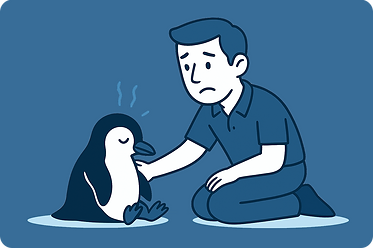
By the time his condition became obvious enough for keepers to notice during their limited daily observations, Colton was in critical condition, requiring emergency intervention.

As the team worked through the night to save him, one question kept repeating: why couldn't we see this coming? Why did our systems fail to connect these subtle dots until it was almost too late?

This scenario, unfortunately common across zoological institutions globally. Captive African penguins often faces physical and mental health challenges that are unnoticed in time.

This situation inspired us to create PenguBuddy — a solution that is not only a streamlined early-warning system, but also an enrichment tool that fundamentally promotes better physical and mental health.
PROBLEM STATEMENT
How can an AI-integrated system enhance the monitoring of African penguins' health and behavior in captivity, while also providing enrichment to promote physical and mental well-being?
FINAL SOLUTION
SYSTEM INTEGRATION
PenguBuddy is an interactive system that connects visitors, penguins, and caretakers. The system includes an underwater robot, a B2B web platform, and a mobile app. My focus in this project is the interactive robot and the web platform.

DESIGN FEATURES
Centralized Dashboard & Team Collaboration
Monitor real-time penguin health and behavior, stream live footage, and collaborate seamlessly. All in one smart, connected platform.
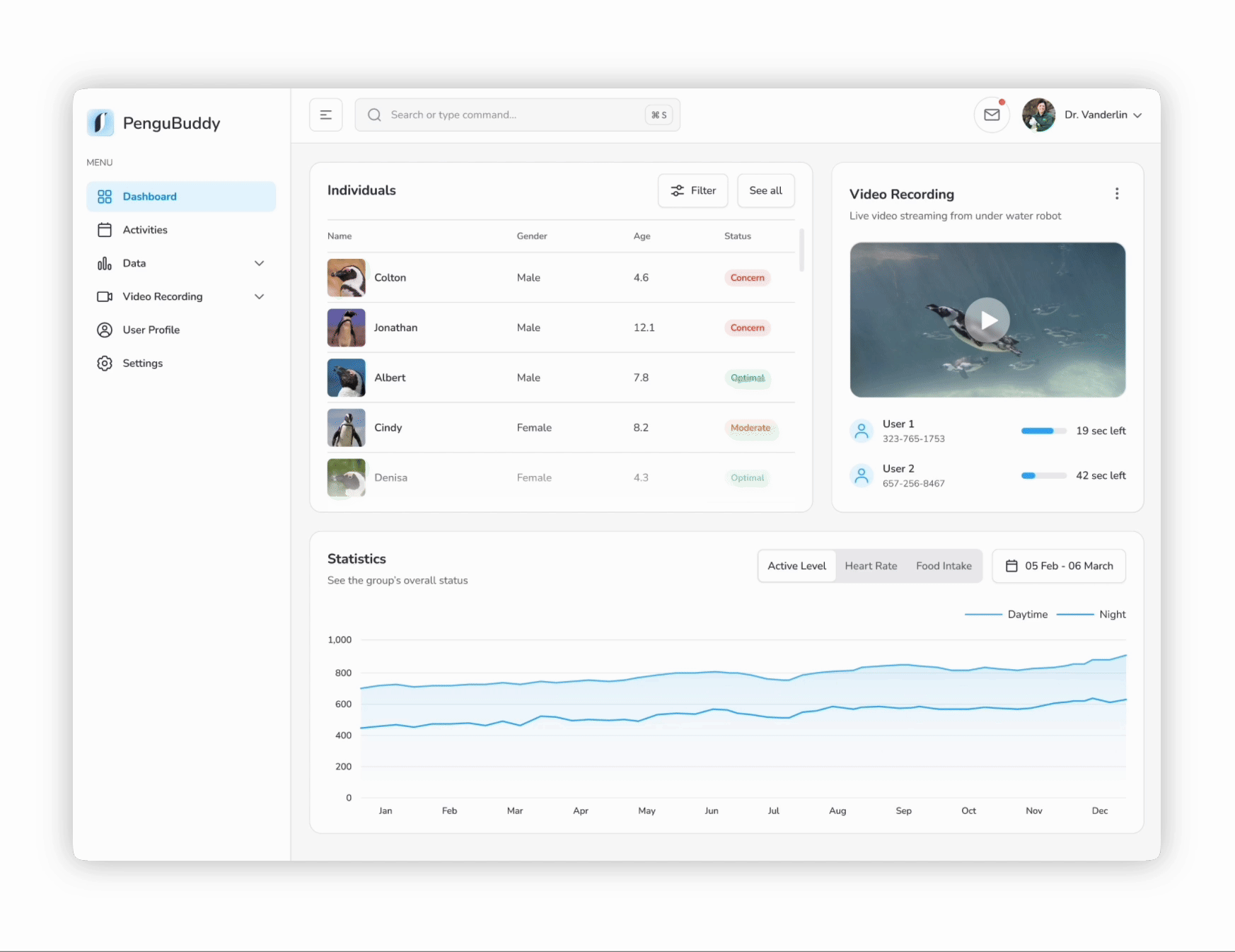
Precision Care,
Powered by Data
Gain detailed insights into the health and behavior of individual penguins while easily managing the monitoring robot.
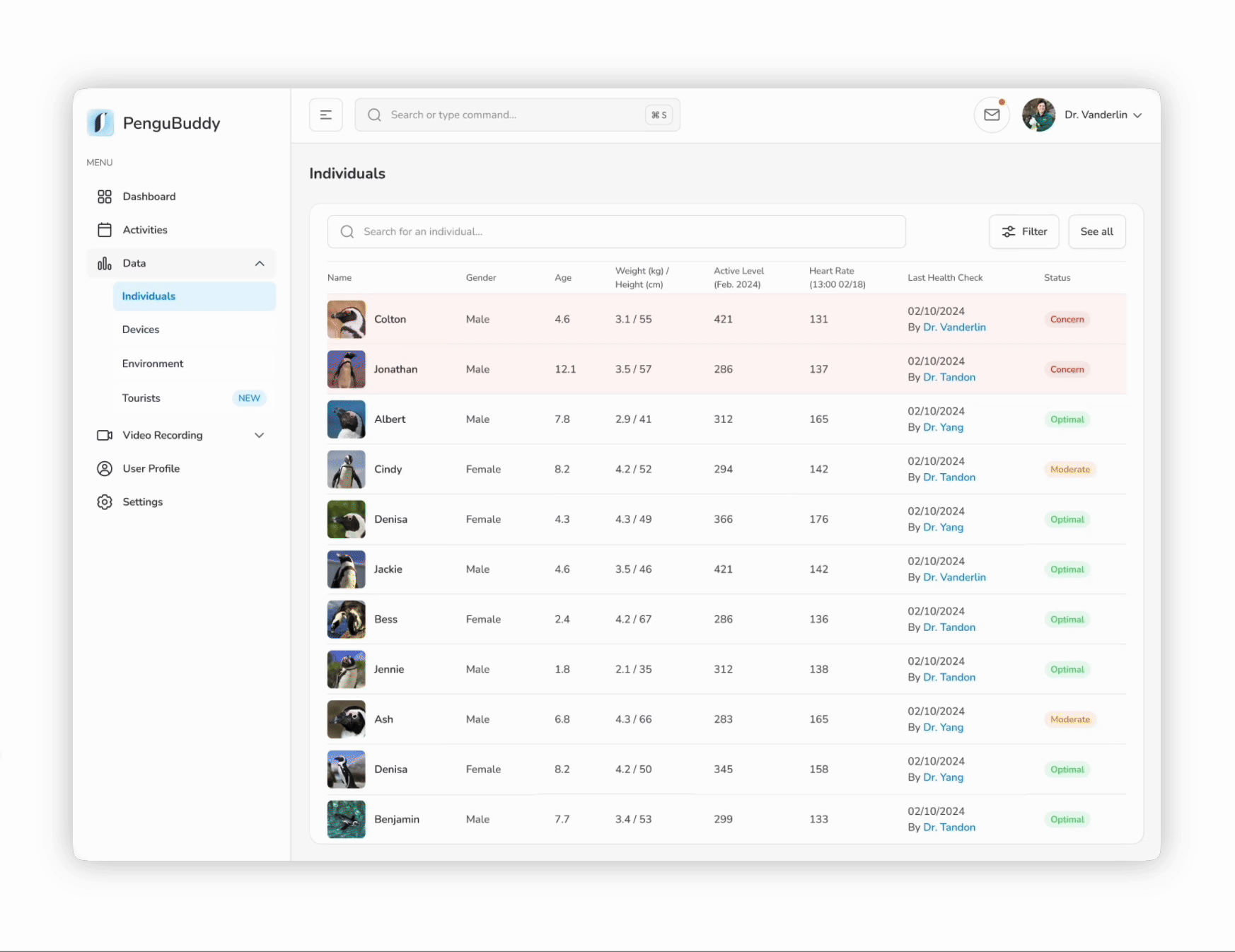
Smarter Care
Schedule & Planning
Manage penguin health routines with AI-suggested treatments, visual scheduling, and real-time task tracking.
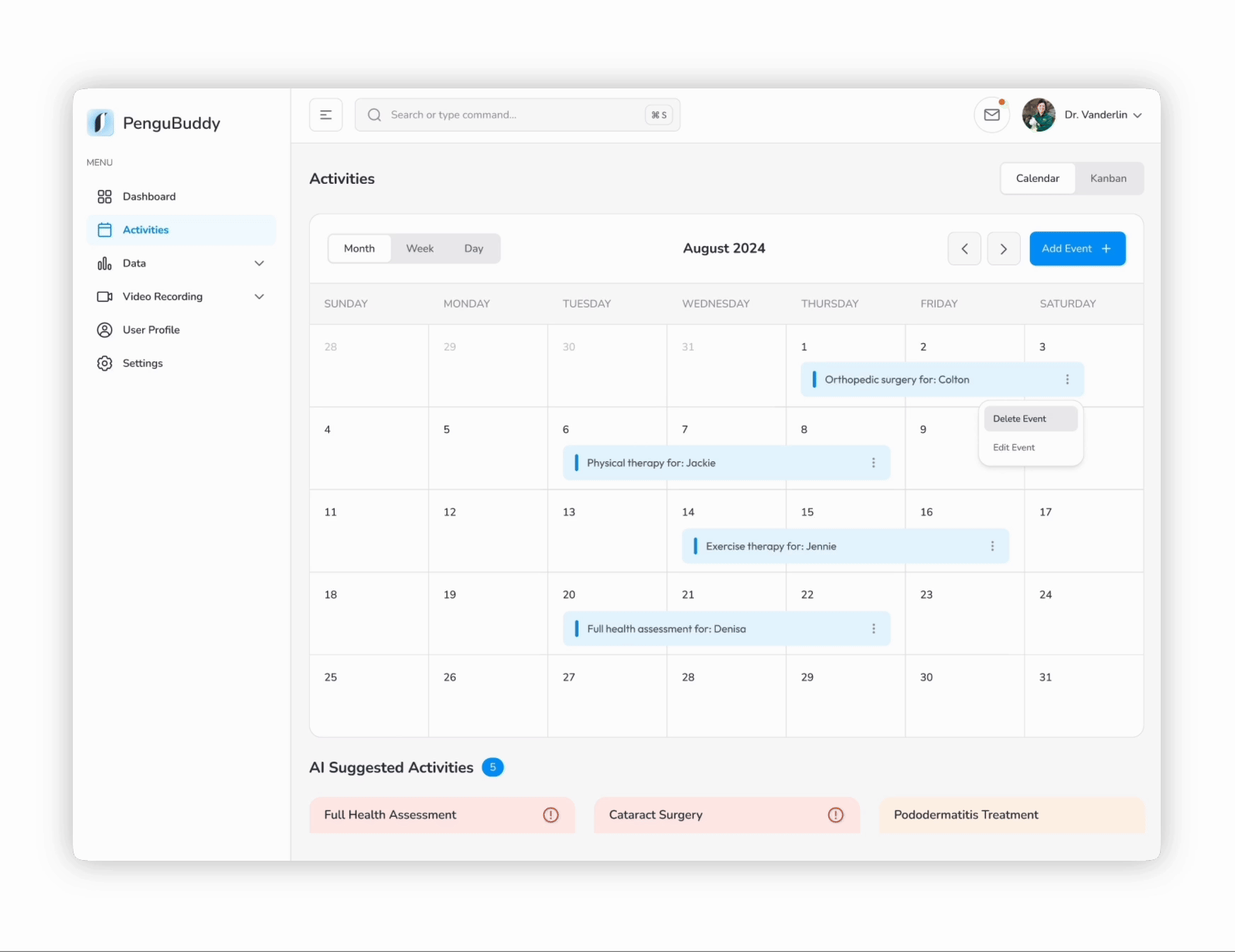
AI-Powered
Behavior Alerts
AI flags unusual penguin behaviors and delivers instant video clips to support early action and informed care.
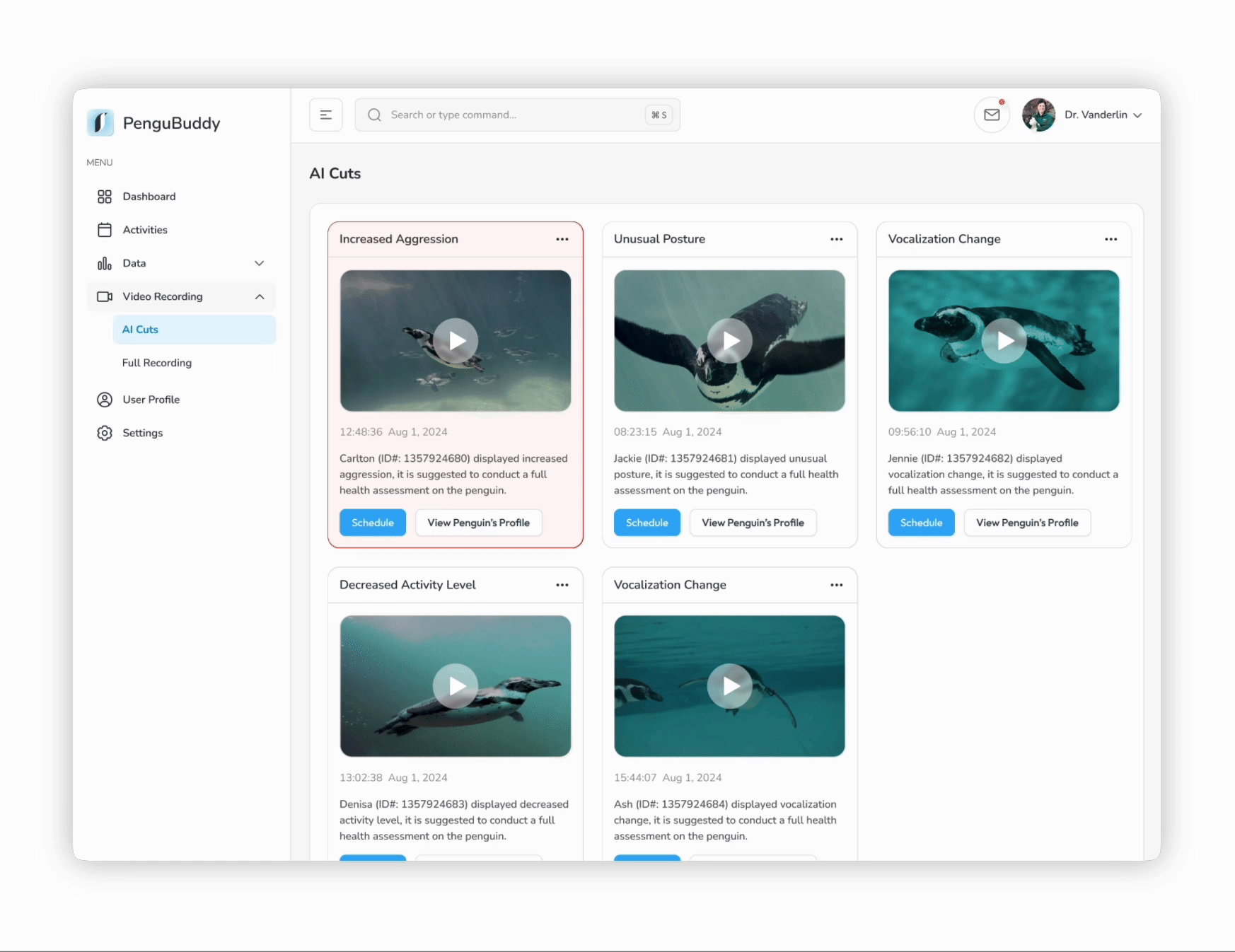
INITIAL RESEARCH
CONTEXT
Welfare of captive African penguins
Insufficient welfare monitoring

WELFARE OF CAPTIVE AFRICAN PENGUINS
https://www.penguinsinternational.org/enrichment-for-penguins-is-it-needed-and-can-it-be-successful/
Welfare refers to an animal’s physical and mental condition, particularly its ability to cope with its environment. It can be enhanced through environmental enrichments and monitored in two main ways: by tracking biometrics and observing behavior.

HOW TO IMPROVE WELFARE?
https://www.penguinsinternational.org/enrichment-for-penguins-is-it-needed-and-can-it-be-successful/
Enrichment
Enrichment strategies that reflect natural conditions—such as environmental features, access to food in stimulating ways, social interaction, cognitive challenges, and sensory engagement—are essential for supporting the physical and mental well-being of captive penguins. By bridging the gap between the wild and artificial environments, enrichment helps ensure a healthier, more fulfilling life for penguins in human care.

HOW TO MONITOR WELFARE?
Biometric Indicators

Hormones
Glucocorticoids, such as cortisol and corticosterone, are released into the blood during a stress response.
Behavioral Indicators

Reduced activity
Reduced activity levels, often paired with prolonged periods of rest and decreased engagement in natural behaviors.

Altered feeding patterns
Diminished appetite, though anticipation around feeding times may still be observed.

Heart rate
the rise in heart rate can indicate stress, which may result from disturbances such as human or environment.

Aggressive interactions
Increased aggression and decreased social or friendly behaviors toward other penguins and caretakers.

Grooming behavior changes
Noticeable changes in grooming habits, such as excessive or repetitive preening, impacting the penguin's health.
ON-FIELD RESEARCH
To have a better understanding on what the daily routine is like taking care of African penguins, we visited Georgia Aquarium at Atlanta and the National Aviary at Pittsburgh. By interviewing keepers and observing penguins, we discovered the following insights:
Common used and effective enrichment is:
interactive toys
Novel objects are frequently provided to serve as toys, and they are more welcomed if they can easily move or float. Some commonly used objects as enrichments are balls, mirrors, tires, or even bubbles.
Biometric monitoring is intuitive,
but skewed and impracticable
Hormone tests reflect quantitative data directly, but obtaining blood samples is required, and this process can be invasive and can act as a source of stress itself. In addition, blood sampling is a complex process and thus is only conducted twice annually, making it unsustainable.
Behaviors can be tracked by microchips,
but is limited and not read frequently
Captive African penguins are commonly implanted with microchips, but they only provide basic data like movement and activity levels when scanned nearby. They don’t capture detailed behaviors such as aggression, feeding, or grooming. In addition, they lack real-time GPS capabilities, and data is usually retrieved every two weeks.

MARKET RESEARCH
We then examined the current approaches used to improve and monitor the welfare of captive African penguins. By analyzing their strengths and weaknesses, we gained inspiration and identified potential design opportunities.
Common forms of enrichment
Penguins have color vision and are naturally sensitive and curious toward moving objects. As a result, enrichment items often share features such as reflectivity and mobility.

Balls
Mobility, affordability
Visibility

Tires
Durability, affordability
Visibility, mobility

Disco balls
Visibility
Mobility, durability

Bubbles
Visibility, mobility
Sustainability
Attempts of monitoring systems

Mirror objects
Visibility
Mobility, safety

Interactive toys
Mobility, interaction
Safety, sustainability
Most successful monitoring methods either use radio frequency to read data from chips attached to individual penguins or employ movable cameras to capture live footage. Hormone testing is less commonly used in practice to assess welfare. Some examples show that monitoring robots not only avoid causing stress like human presence can, but also spark penguins' curiosity and encourage enriching interactions.
Cincinnati Zoo
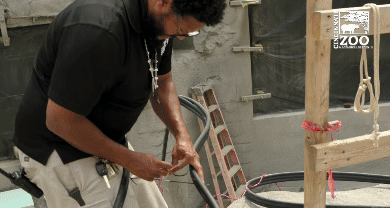
A built-in Radio Frequency Identification system (RFID) in the pool reads from the microchips and updates data 24/7.
Data acquisition
Video footage, engagement, cost
Echo
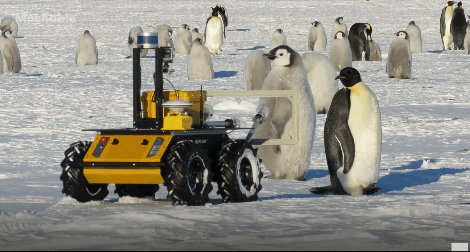
A semi-autonomous robot also using RFID technology helps scientists in Antarctica to keep tabs on emperor penguins.
Data acquisition, video footage
Engagement
BBC Penguincam

A penguin-shaped disguised camera captures footages of real penguins while stimulating their curiosity.
Video footage, engagement
Data acquisition
CONCEPT DEVELOPMENT
DESIGN DIRECTION
PenguBuddy acts as both a welfare monitor and an enrichment tool for penguins in captivity. By combining AI-powered real-time monitoring with interactive engagement, it not only detects early signs of health or behavioral issues but also addresses them at the root.

INTERACTIVE SYSTEM
To address welfare from both enriching and monitoring system, PenguBuddy is formed by three products: an underwater robot that serves both as a toy for the penguins and a monitor, a mobile app that allows visitors to interact with the robot, and a B2B web platform that serves keepers by tracking data and automatic analysis.
The following pages will be focusing on the design process of the B2B web platform.

IN-DEPTH RESEARCH
INDICATORS OF WELFARE
To accurately and comprehensively assess the welfare of captive African penguins, five key areas serve as critical indicators, offering essential data that help keepers and biologists better understand the animals’ well-being. By analyzing existing solutions and gathering input from various stakeholders about their challenges and expectations, we will evaluate and identify the specific indicators to monitor.

COMPETITIVE ANALYSIS
Current product
The team at Georgia Aquarium currently uses a platform named ZIMS by Species 360 to track and document health data of African penguins. It is a widely used software platform designed to support the comprehensive management of animal records, medical histories, husbandry data and studbooks.

Current user flow

Pain points of current system

DESIGN NEEDS
To identify specific design needs, we interviewed different stakeholders in the aquarium, and asked about their experience and opinion on the current managing system. We discovered that their expectations align with the pain points that we identified for the current model.

RESEARCH QUESTION
How might we create a semi-automated, centralized, real-time, and multimodal system to help teams monitor animal health and coordinate care more efficiently?
DATA SELECTION
After comprehensive evaluation of the tradeoffs to include each data based on data importance, feasibility, budget, and product vision, we made a decision to collect the following data sets for our MVP.

IDEATION & PROTOTYPE
USER FLOW

LOFI PROTOTYPE

DESIGN SYSTEM
I created a scalable design system that promotes visual consistency and accessibility by integrating WCAG guidelines, inclusive design principles, and clear documentation to support cross-team implementation.

ITERATIONS

This example presents multiple versions of a featured page, illustrating the design’s evolution across iterations while addressing goals such as design feature needs, alignment with the design system, and improved usability.
The Lo-Fi prototype is designed to experiment with the general usability
Specific content is added to the page to test the feasibility of the Lo-Fi layout
Design system is constructed and implemented to align the visual design across the platform
The layout is changed from a pop-out half page to a full page to optimize the usability of additional secondary pop-out screens and cards
The page is revolved to a scrollable design to fit more information catering to design needs
After an internal design audit and user testing, we identified several issues in the individual page of the initial version:
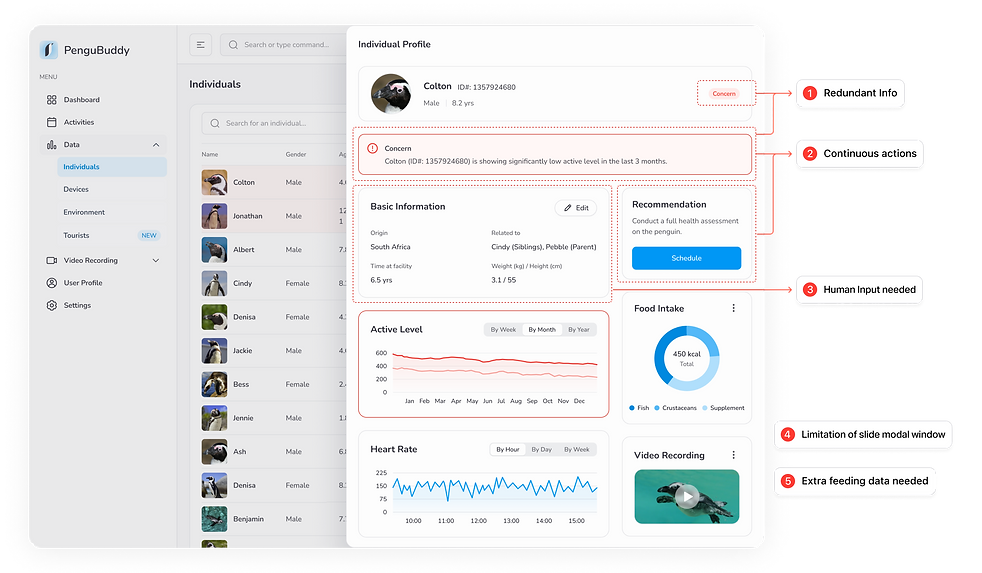
The alert section had redundant components, both a badge and an alert message.
Alert messages and follow-up recommendations, part of a continuous action flow, were siloed, disrupting the user workflow.
The design lacked flexibility, with no space for keepers to add notes that couldn’t be captured by the robot.
Using a slide-in modal limited deeper interactions like tagging or editing, leading to overlapping modals and poor usability.
Insights from a nutrition specialist highlighted feeding times as a critical data point that needed to be included.

I replaced the modal with a dedicated subpage and added a breadcrumb for easier navigation.
Alert and follow-up recommendations were combined into a streamlined insight component aligned with user workflows.
I added a notes section for keepers to manually input observations, offering better flexibility.
Based on feedback from the nutrition team, I integrated feeding data into the profile and reorganized the layout accordingly.
CONCLUSION
NEXT STEPS
1. User Testing
Validate the system with real caretakers and refine based on feedback.
4. Refine & Expand Features
Improve AI insights and add nutrition tracking, multimodal inputs, etc.
2. Collaborate with Dev Team
Work closely with engineers to align on feasibility and implementation.
5. Plan MVP & Pilot
Finalize core features and prepare for a real-world trial deployment.
3. Incorporate Environmental Data
Add sensors or inputs for factors like temperature, light, and noise.
6. Scale to More Taxa
Adapt the system to support other species beyond penguins.
POTENTIAL IMPACT
1. Less Reliance on Manual Monitoring
Automated tracking saves time and reduces errors.
4. Enrichment Through Play
Robots keep penguins active and engaged.
2. Proactive Health Care
AI flags risks early, supporting timely interventions.
5. Scalable System
Designed to expand across species and facilities.
3. Efficient Teamwork
Centralized tools streamline daily care and communication.
6. Long-Term Welfare Insights
Trends reveal chronic issues and guide better care.
WHAT DID I LEARN?

Building for
Multi-Stakeholder Needs
From vets to trainers, I balanced overlapping roles and data needs to create a platform that works across disciplines.

Scalability
Through Focus
Designing deeply for one species (penguins) helped me build a flexible, scalable framework for broader B2B applications.

Driving Clarity Through
Systems Thinking
Simplifying health metrics, task flows, and AI outputs taught me how to turn fragmented data into actionable, user-centered systems.
